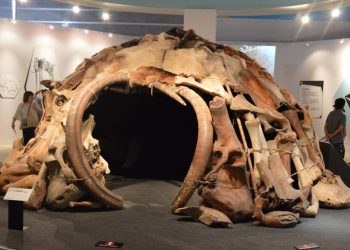Imagine facing a six-ton mammoth with only your wits and a few primitive tools. It’s hard to picture how our ancestors, weighing roughly 190 pounds, could stand a chance. However, recent research has shed light on an innovative hunting method that might have allowed early humans to level the playing field. Popular depictions often show ancient humans hurling spears at mammoths, their sharp Clovis points piercing through thick hides. But a groundbreaking study from archaeologists at UC Berkeley suggests a different, more strategic approach. Instead of relying on the force of a thrown spear, these early hunters likely planted their spears in the ground, using the momentum of a charging mammoth to drive the weapon deep into the animal’s body. Researchers argue that this technique would have been much more effective and akin to the impact of a modern hollow-point bullet. The idea that Homo sapiens contributed to the extinction of megafauna like mammoths through overhunting has long been debated. Yet the question has persisted: how could relatively small, fragile humans bring down such massive creatures 13,000 years ago? The traditional image of a hunter tossing spears at a towering mammoth, now challenged by this new study, may need revision.
According to the UC Berkeley team, the method of planting spears—tipped with sharp Clovis points—into the ground was likely a more successful strategy. This approach would have utilized the force of a charging animal, such as a mastodon, bison, or even a saber-toothed cat, to impale itself on the spear, driving it deeper into its body and causing more significant damage than a thrown spear ever could. Scott Byram, the lead author of the study, emphasized the ingenuity behind this ancient technology, noting that it offers valuable insights into the hunting and survival strategies used by indigenous peoples for thousands of years. “This distinctive Indigenous technology is providing a window into hunting and survival techniques used for millennia throughout much of the world,” Byram stated in a press release. The mystery of how Clovis points were used began with their discovery. These fluted, sharp rocks, made from materials like flint or jasper, are among the most common artifacts from that period. However, because only the stone points have survived, archaeologists were left to speculate about the complete weapon system they were part of.
To test their theory, the researchers analyzed historical accounts of hunting with planted pikes and conducted experiments to gauge the force a spear could withstand. Their findings indicated that a spear planted in the ground would withstand much greater force than one thrown, making the former strategy far more effective in taking down large prey. Jun Sunseri, a co-author of the study, highlighted the difference in force between a human-thrown spear and one driven by a charging animal. “The kind of energy that you can generate with the human arm is nothing like the kind of energy generated by a charging animal,” Sunseri explained. “These spears were engineered to do what they’re doing to protect the user.” This new theory also aligns with the notion that Clovis points were valuable resources, requiring significant time and effort to create. It’s unlikely that ancient hunters would have risked wasting them on methods with low success rates, further supporting the idea that pike hunting was a preferred strategy.
Byram noted that sometimes in archaeology, evidence begins to align, and that seems to be happening with Clovis technology and pike hunting. “This puts pike hunting front and center with extinct megafauna,” he said, suggesting that it offers a fresh perspective on how early humans coexisted with these giant creatures. Although this new theory is compelling, Byram and his team plan to conduct further tests using a replica mammoth better to simulate the potential effectiveness of this hunting technique. Because archaeologists only recover Clovis points and not the complete weapon systems, it remains challenging to confirm this theory with absolute certainty. If these additional tests confirm the hypothesis, our understanding of how indigenous peoples thrived in the Americas over 13,000 years ago may need to be significantly revised. This research could rewrite the narrative of early human survival and ingenuity in the face of seemingly insurmountable odds.




![A piece of decorated ivory retrieved from the ruins. [PHOTO/XINHUA]](https://curiosmos.com/wp-content/uploads/2024/12/A-piece-of-decorated-ivory-retrieved-from-the-ruins.-PHOTO-XINHUA-120x86.jpeg)






